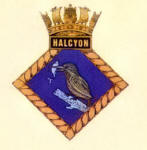Summary of History
 HMS
HALCYON (J42) was the first of the 21 HALCYON Class ships constructed. She
was laid down on 27th March 1933 at J. Brown, Clydebank and
was commissioned 18th March 1934. She spent much of the
next few years at Portland and Alexandria in the Med carrying out
trials with later HALCYON Class ships (see
Specifications for
details). She started her war at Harwich, clearing mines in the
Channel. At the evacuation of
Dunkirk
she transported 2,271 troops until she had to be withdrawn due to
damage following air attack. It was at Dunkirk that two crew members
were killed, HALCYON's only casualties of the war. After repairs
she reverted to mine clearance off the east coast where she was
subjected to almost daily air attack. She was badly damaged by a mine
explosion in September 1940, her stem was under water by the time she
dry docked. Repairs took until July 1941. HALCYON then sailed for
Iceland where she provided A/S protection. Building on this experience
she then sailed for North Russia with the first convoy to sail to
Archangel.
She remained in North Russia to keep the ports clear of mines and to
escort the incoming and departing convoys. Returning to UK in October
1941 she was fitted out for arctic service in London. In December 1941
she sailed with three other HALCYONS as part of Operation Anklet, the
landing of commandos on the Lofoten Islands. Although due to sail with
PQ8, damage to her starboard shaft
and serious structural
damage
in a storm meant she had to return to Aberdeen for repairs.
HMS
HALCYON (J42) was the first of the 21 HALCYON Class ships constructed. She
was laid down on 27th March 1933 at J. Brown, Clydebank and
was commissioned 18th March 1934. She spent much of the
next few years at Portland and Alexandria in the Med carrying out
trials with later HALCYON Class ships (see
Specifications for
details). She started her war at Harwich, clearing mines in the
Channel. At the evacuation of
Dunkirk
she transported 2,271 troops until she had to be withdrawn due to
damage following air attack. It was at Dunkirk that two crew members
were killed, HALCYON's only casualties of the war. After repairs
she reverted to mine clearance off the east coast where she was
subjected to almost daily air attack. She was badly damaged by a mine
explosion in September 1940, her stem was under water by the time she
dry docked. Repairs took until July 1941. HALCYON then sailed for
Iceland where she provided A/S protection. Building on this experience
she then sailed for North Russia with the first convoy to sail to
Archangel.
She remained in North Russia to keep the ports clear of mines and to
escort the incoming and departing convoys. Returning to UK in October
1941 she was fitted out for arctic service in London. In December 1941
she sailed with three other HALCYONS as part of Operation Anklet, the
landing of commandos on the Lofoten Islands. Although due to sail with
PQ8, damage to her starboard shaft
and serious structural
damage
in a storm meant she had to return to Aberdeen for repairs.
Upon
completion of the repairs in June 1942 she sailed with PQ17 for
Russia. When the convoy was ordered to scatter she was ordered to sail
with HMS Palomares and headed for the shelter of the island of Novaya
Zemlya. On 6th July she mistook a rapidly closing HMS
Salamander for a German destroyer that had been reported in the area
and opened fire. Frantic signalling from the mast of Salamander soon
corrected the error. Meeting up with other ships of the convoy they
fought their way to Archangel but then immediately went out again to
search for survivors.
HALCYON remained in
North Russia
carrying out a range of duties until returning to the UK in November
1942 with QP15. She encountered hurricane force winds which she
faced with a grim determination that drew the admiration of Rear
Admiral Hamilton who later wrote…
Even from the interchange of the few signals I had had first with
Salamander and now with HALCYON I could not but be impressed by the
cheerful way in which these very small ships were coping with their
difficulties. With so little reserve of speed, conditions in these
vessels must have been even worse than in a destroyer. HALCYON must
have wondered more than once what happened when his fuel gave out in a
position of which he was very unsure; and I would like to express my
admiration for the manner in which these small ships carry out their
vital, arduous and unglamorous work.
HALCYON sailed straight to Milford Haven in December 1942 for a much
needed refit. She then spent most of 1943 escorting ships in
Iceland, UK, Londonderry and Gibraltar. In November she returned once
more to North Russia with JW54B, returning to Scapa in February
1944.
In March 1944 she joined her sister ships in the 1st MSF
and started exercises in readiness for D Day. On D Day they swept the
assault ships in to
Sword Beach along Channel 9, later turning to broaden the swept areas
and provide protection from attack during the night. By the 20th
August HALCYON had returned to London for refit, completing on the 23rd
November. She then cleared mines in Antwerp and the North Sea based in
Harwich. After a long series of repairs, HALCYON finally was allowed
to go into the Reserve in May 1946. She was sold on 19th
April 1950 to BISCo and left on the 28th to be scrapped by
Ward, Milford Haven.

